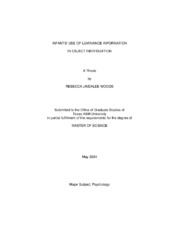| dc.description.abstract | Recent research suggests that by 4 months of age infants are able to individuate objects using form features, such as shape and size, but surface features, such as pattern and color, are not used until later in the first year (Wilcox, 1999). The current study sought to investigate two possible explanations for this developmental hierarchy. The visual maturation hypothesis suggests that the order in which infants use features to individuate objects corresponds to the order in which they are most readily processed by the developing visual system. A second hypothesis, the information processing biases hypothesis, suggests that infants are biased to attend to form features because form features provide information that is relevant to reasoning about object interactions. One way to test these hypotheses is to investigate infants' ability to individuate objects based on luminance. Luminance is detected at birth, so, according to the visual maturation hypothesis, luminance, like shape and size, will be used to individuate objects early in the first year. However, luminance is a surface property, so according to the information processing biases hypothesis, luminance, like pattern and color, will be used to individuate objects late in the first year. In the current study, 7-month-old (Experiment 1) and 11-month-old (Experiment 2) infants' use of luminance information in an object individuation task was investigated. The narrow-screen event-monitoring paradigm developed by Wilcox and Baillargeon (1998a) was used. Infants saw an event in which a ball moved behind a screen and a second ball emerged from behind the opposite edge of the screen. In one condition, the balls were identical, suggesting the presence of one object (same-luminance condition), and in another condition, the balls differed in luminance, suggesting the presence of two objects (different-luminance condition). The screen was either too narrow (narrow-screen event) or sufficiently wide (wide-screen event) to occlude two objects simultaneously. Seven-month-olds looked equally at each event, whereas 11.5-month-old's looked longer at the narrow-screen event in the different-luminance condition. These results suggest that 11.5-month-olds, but not 7.5-month-olds used luminance information to conclude that two distinct objects were involved in the event, thus supporting the information processing biases hypothesis. | en |


